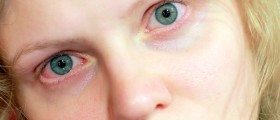
Conjunctivitis is an inflammation that affects the conjunctiva, which is a thin, soft membrane covering the white part of the eye and the inner part of the eyelids.
There are three kinds of the conjunctivitis, depending on what is causing it - irritant conjunctivitis, allergic conjunctivitis and infective conjunctivitis.
Irritant conjunctivitis is caused by agents that irritate the membrane, like chlorine, or a foreign body, usually an eyelash. This type of conjunctivitis usually passes by itself once the irritant has been removed. In case of chemical irritation the eye needs to be flushed thoroughly. Rubbing the eye is not recommended as it may cause considerable damage to its surface.
Allergic conjunctivitis is a reaction of the immune system to allergens. It is usually associated with seasonal allergies.
Infective conjunctivitis is caused by bacteria, viruses or sexually-transmitted infections, like gonorrhea or chlamydia. The symptoms of this type of conjunctivitis include redness and swelling of the eye, tearing, formation of a thin crust, especially in the morning, that can glue together the lashes making it difficult to open the eyes completely.
This type of conjunctivitis is very common and it is makes up a large portion of eye-related conditions and diseases. It seems to affect children more, who are more exposed to bacteria and viruses in school or kindergarten, and the elderly, whose immune system is weakened by old age.
In most cases, infective conjunctivitis requires no treatment and heals after a few weeks. However, if the causes of are sexually-transmitted infections, it may be best to consult a doctor.
Newborn babies, who are less than a month old are considered to be at risk of complications following conjunctivitis and if they develop it, it is best to see a pediatrician in order to avoid further and more serious damage to the eye and sight.
Possible complications of bacterial conjunctivitis are meningitis, which is an inflammation of the brain membrane, cellulitis, which affects deeper layers of skin and causes inflammation, septicaemia or blood poisoning due to penetration of bacteria into the blood stream, ear infections and punctate epithelial keratitis.
Keratitis is an inflammation of the cornea, possibly with ulcers and punctate epithelial keratitis includes small holes in the conjunctiva. This condition may cause pain and discomfort and it takes up to several weeks to clear.
Infants who have conjunctivitis caused by chlamydia are at risk of developing pneumonia, which can be very dangerous at such a young age and requires intensive monitoring and treatment in a hospital.

















Your thoughts on this
Loading...